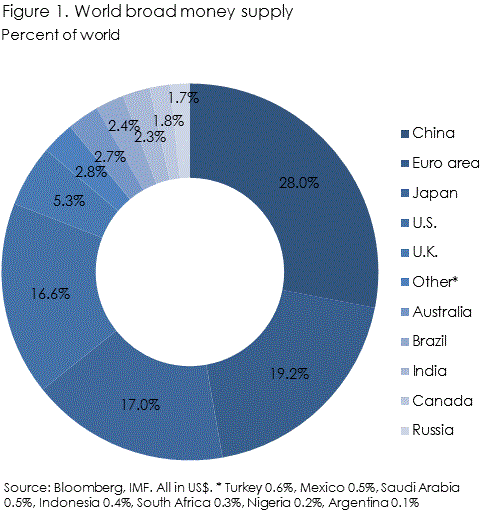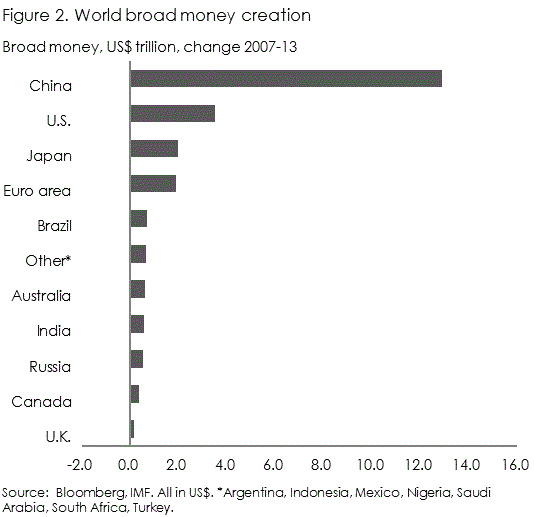The Chinese money wall
Milken Institute London Summit, 28 October 2014 (revised)†
Ousmène Jacques Mandeng, Global Institutional Relations Group, Prudential Investment Management
The adoption of unconventional monetary policies by several leading central banks has raised widespread concerns about undue monetary expansion, possible asset price distortions and exchange rate manipulations and related adverse external spillovers. However, the biggest monetary threat may be quite a different one. China dominates monetary issuance today by far. The world broad money supply has nearly doubled since the beginning of the global economic and financial crisis mostly due to China. Unless money is entirely neutral, the significant shift in relative inter-country monetary balances is likely to have some real and relative price implications. It is similarly likely to be a key determinant for the further integration of China into the international financial system.
The geography of money supply has changed significantly with the crisis. Broad money, comprising currency, demand and time deposits, increased from 70 percent of world GDP in 2000, to 74 percent in 2007 and to 89 percent in 2013.1 In 2013, China represented 28 percent of world broad money supply compared with 19 percent for the Euro area and 17 percent each for Japan and the U.S. (Figure 1). The U.S., Japan, Euro area and the U.K. had thus 58 percent of world broad money in 2013 compared with 73 percent in 2007 and 82 percent in 2000. Broad money in nominal local currency terms has increased per year on average in 2008-13 by 6.7 percent in the U.S., 4.1 percent in the U.K., 3.8 percent in the Euro area and 2.3 percent in Japan; in China, broad money increased by 18.4 percent during the same period. World broad money is up in nominal terms by US$23.9 trillion in 2007-13 of which China represented US$12.9 trillion (Figure 2).
Broad money remains a principal indicator for inflationary pressure and guide for monetary policy. There is a strong theoretical presumption that growth in monetary aggregates should be linked to economic activity and inflation. However, deregulation, financial innovation, in case of the U.S. a large proportion of currency held abroad and in particular in emerging markets financial deepening has changed reliance on monetary aggregates as an indicator for economic activity and the formulation of monetary policy. The crisis has further changed liquidity preferences and saw a significant increase in several countries in the proportion of output to broad money or decline in money velocity. The decrease in opportunity costs of holding liquid monetary balance amid low interest rates has also affected the money stock. These factors have caused some instability between monetary aggregates and economic activity. At the same time, most central banks would attest that understanding the movements of broad money remains important especially to assess future inflationary pressure. The collapse of the money multiplier, the ratio between broader money aggregates and the monetary base, comprising currency and bank reserves at the central bank, in several countries and in particular with central banks conducting quantitative easing has rendered more significant broad money relative to narrower monetary aggregates.
Market liquidity and international spillovers remain two key attributes of broad money. Short- to medium-term bank liabilities can fund transactions in assets markets and credit expansion and be readily transformed into assets. High money stocks, while also displaying certain liquidity preferences, may thus lower funding costs and support asset transactions. This may lead to a relatively close correlation between broad money and asset prices (and accusations that lax monetary policy has led to an undue inflation of asset prices). Similarly, increases in liquidity in one country may affect financial and monetary conditions in other countries. The international dimension of broad money implies that asset prices and exchange rates may be impacted if broad money leaks out of one country to another. With the beginning of the global and financial crisis, widespread concerns about adverse spillovers in particular for emerging markets and undue effects on exchange rates (“currency wars”) suggest that asymmetric increases in broad money across countries may lead to significant exchange rates or relative price adjustments. The incidence of broad money spillovers naturally depends on countries’ willingness and/or possibility to hold net external assets.
China holds the world’s largest broad money stock by a long way. The Chinese money wall has the potential to exert considerable pressure on the international financial system directly and through the spillover channel. This has already occurred in part. The rapid build-up of foreign exchange reserves, funded by issuance of broad money, and high concentration of reserve holdings by currency and asset classes has most certainly affected price formation and price levels in the underlying asset markets, e.g. the U.S. treasury securities market.
China has maintained widespread financial account controls allowing only partial international integration. Outward investments and portfolio inward investments have remained highly restricted. China’s large net creditor international investment position is dominated by China’s considerable holdings of external assets through the People’s Bank of China’s foreign exchange reserve accumulation and external assets held mostly by other public sector institutions. The net effect of further integration on the rest of the world will depend to what extent China will allow changes in China’s international investment position—China’s net international investment position was US$2 trillion at end 20132—that is, acquisitions of external assets to be substitutes or complements of net external assets. The former should not have an exchange rate impact, except inter-temporal fluctuations given non-coincident gross asset and liabilities movements, but may still lead to changes in asset prices if new external acquisitions occur in asset classes other than prevailing holdings. The latter, given the scale of China’s monetary balances, could produce significant exchange rate and asset price adjustments. China’s broad money stock stood at US$18.5 trillion or 25 percent of world GDP or significantly more than the U.S. component of the market capitalisation of the Barclays Global Aggregate Index at end-2013. While only a fraction would likely ever move abroad, it is still lot of money potentially hitting international markets.
The threat of the Chinese monetary balance will largely depend on how China liberalises. Recent policy measures seem to point to faster liberalisation of the financial account although mounting concerns about the world economy may lead to a review of the pace of reform implementation. While financial account liberalisation has often been associated with the risk of further capital flows into China, China may well be more preoccupied with capital outflows. Given China’s large creditor international investment position, the prudent approach would be to allow inflows while allowing outflows to the extent that there will be no significant shift in the short term in China’s international investment position. China may also contemplate sterilising or absorbing through regulatory changes or otherwise liquid monetary balances before allowing outflows but this may be costly and its effect uncertain.
The Chinese money wall may well dwarf anything in the international financial system including unconventional monetary policy. Yet, much of course will depend to what extent China and the rest of the world is willing to hold each other’s assets and over what time horizon. If the rest of the world is not too willing to hold more Chinese assets but China is willing to hold more rest of the world assets, then China may need to control outflows very tightly. If China is not too willing to hold assets of the rest of the world and the rest of the world is also not too willing to hold Chinese assets, then liberalisation offers no major challenge. If the rest of the world is willing to hold Chinese assets but China is not willing to hold more rest of the world assets, then China will find it hard to liberalise capital inflows. Most likely, it will be some combination of the former scenarios. This suggests that China needs to show flexibility and adaptability with the implementation of financial account liberalisation. Otherwise, the rest of the world or China may suffer. It is the rest of the world though that seems to be at bigger risk.


† Excerpts presented during a panel discussion.
1 All monetary data refer to Argentina, Australia, Brazil, Canada, China, Euro area, India, Indonesia, Japan, Mexico, Nigeria, Russia, Saudi Arabia, South Africa, Turkey, United States and United Kingdom representing 82 percent of world GDP in 2013. >/p>
2 IMF China staff report, 2014 Article IV consultation.